-
Content Count
1,815 -
Joined
-
Last visited
-
Days Won
2
Content Type
Profiles
Forums
Calendar
Posts posted by Merthyr Imp
-
-
A bit after my time, but I do recall a corner green grocer opposite the school on Blue Bell Hill, and down on the same side near the bottom was a row of shops, too long now for me to remember what they were.
We moved to the Meadows around 1960ish due to Mum resigning as Manager of the Lady Bay Cleaners shop.
I can't picture it exactly now myself after more than 50 years, and what order they were in, but going down Blue Bell Hill Road from the school, on the same side there was some sort of commercial premises that - as I remember - usually seemed to have several Guy lorries or vans (painted dark blue?) parked in their entrance. There was the Hop Pole pub, and a few houses. Like I say, I can't remember what order these came in. Then was our shop - the usual corner shop type of place (except it wasn't on a corner!), but we weren't a greengrocers - then next door WAS a corner shop - a beer-off - on the corner of Crown Street, I think it was, run by Mrs Marshall.
More or less across the road from where we were, I can remember a couple of shops - the bakers, run by Mr Griggs, whose daughter Maxine I was at school with, and a paper shop, where I can remember the Evening News still being on sale alongside the Evening Post. There was always a great smell of baking bread in the mornings from Mr Griggs's shop, and sometimes us kids would have a freshly-baked roll for breakfast from there - still warm. Delicious! - you didn't need butter on it.
-
 2
2
-
-
I was brought up in St Anns, lived at Number 4 Kings Lynn Terrace off Turner Street in the 50's, went to Blue Bell Hill and Huntingdon sec school from 1958 to 1962.. Also live on Alfred Street South at the Lady Bay Cleaners, Mum was managing the shop, opposite Agar's green grocers shop at the corner of Blue Bell Hill.
I went to Blue Bell Hill school from autumn 1959 until leaving at age 11 in summer 1961. I've got a class photo from 1960 somewhere - I'll see if I can dig it out and put it on here.
We lived a short way down Blue Bell Hill Road from the school where my mother had a shop.
-
Re the earlier queries about MacFisheries shop on South Parade, you can see part of it behind this West Bridgford bus. Halfords was to the left. Photo taken in the late 1960s.
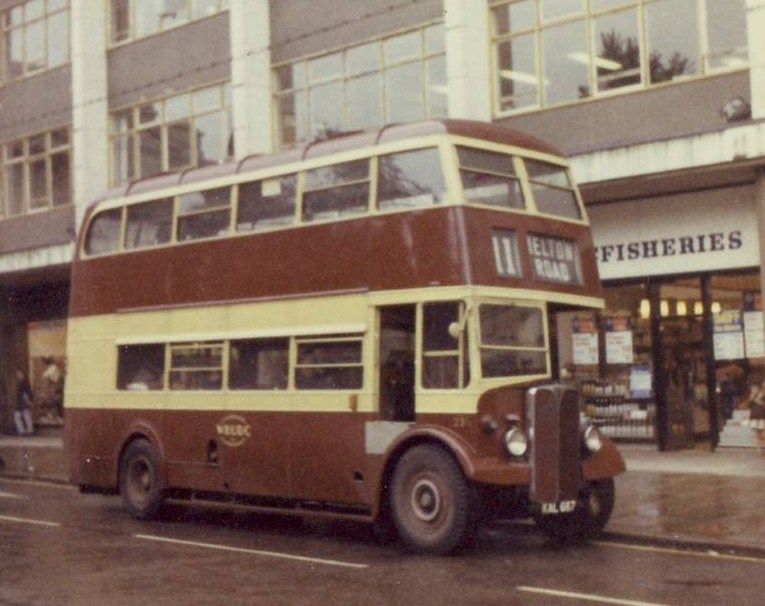
-

Here's another photo from the same period - Midland General no. 89, an AEC Regent lll dating from 1948.
I was puzzled by its showing route A1 as I can only really remember B8s at Huntingdon Street, but I've done a search and according to the website below, the Ripley service that replaced the A1 trolleybuses was numbered B1 and ran to Mouint Street. It then says: 'A new peak hour bus service was introduced on weekdays and Saturdays. It was numbered A1 and followed the trolleybus route through the city but was extended to Huntingdon Street bus station.' It goes on to say that in 1971 the A1 peak hour service only ran on weekdays and was diverted to Mount Street bus station'
http://focustransport2011.blogspot.co.uk/2011/05/ripley-to-nottingham.html
-
 1
1
-
-
Here's one of NCT AEC Regent V no. 268 on route 25. This must have been in 1962 or 1963.
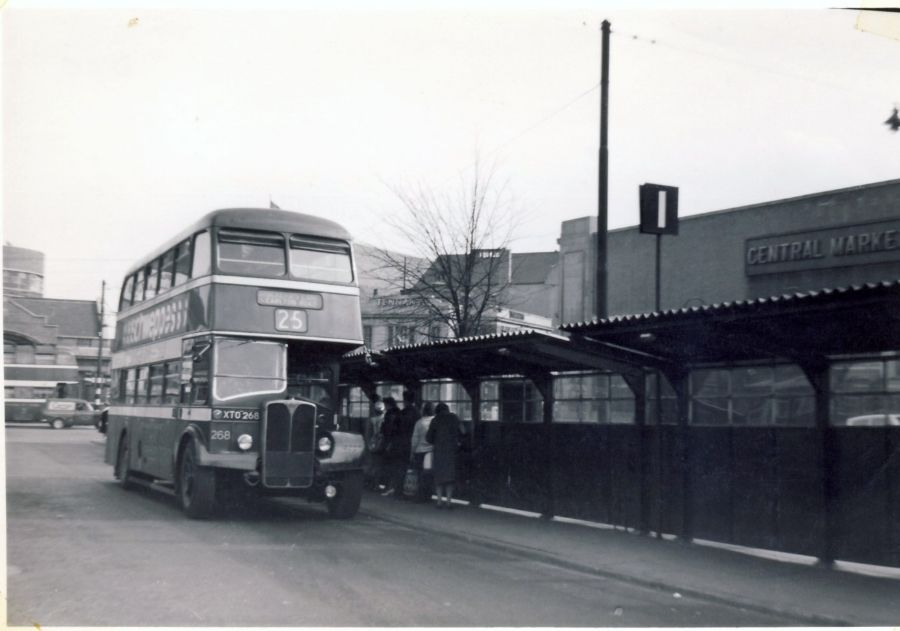
-
 4
4
-
-
By the way, that photo of Barton's AEC Reliance no. 768 shows it on route 12 - the Leicester service.
Looking at it, it reminds me of a time in my bus spotting days, when someone, knowing I collected bus numbers said they'd not really noticed such things before, but that a Barton bus they'd seen that day had rather a long number on it:
"What was it?", I asked.
"254881"
"Er - no. That was their phone number."
-
 1
1
-
-
According to the book 'Barton - Part 2' by Alan Oxly, published by Robin Hood Publishing in 1986, control of Robin Hood (Coaches) Ltd passed to Barton in October 1961, with the business being absorbed from 1st January 1962. It says that Robin Hood had moved their base from West Bridgford in 1939 'when the bus side of the business transferred to a new garage adjacent to Barton on Huntingdon Street.' That implies that the Barton garage was already there. The book says the Robin Hood premises closed at the end of 1961.
There's more information in 'Barton - Part 1' published in 1983. No actual date is given, but it implies it was 1939 when Barton opened that garage: 'Vehicles were transferred from Chilwell to a new garage on Huntingdon Street, Nottingham. These new premises, although small, had a very modern office and enquiry complex, and were adjacent to the garage of Robin Hood Coaches Ltd and Trent's enquiry office.'
I think the confusion may be because - as seen in my photo - it said both Barton and Robin Hood over the entrance to the garage. This would have been because Barton more or less marketed themselves as 'Barton - Robin Hood'. By the end of the 1960s I think almost all their vehicles (except maybe the older ones) bore both names as seen in this photo, for example. So they would have put the Robin Hood name on their garage in the same way as they began to put it on their vehicles.
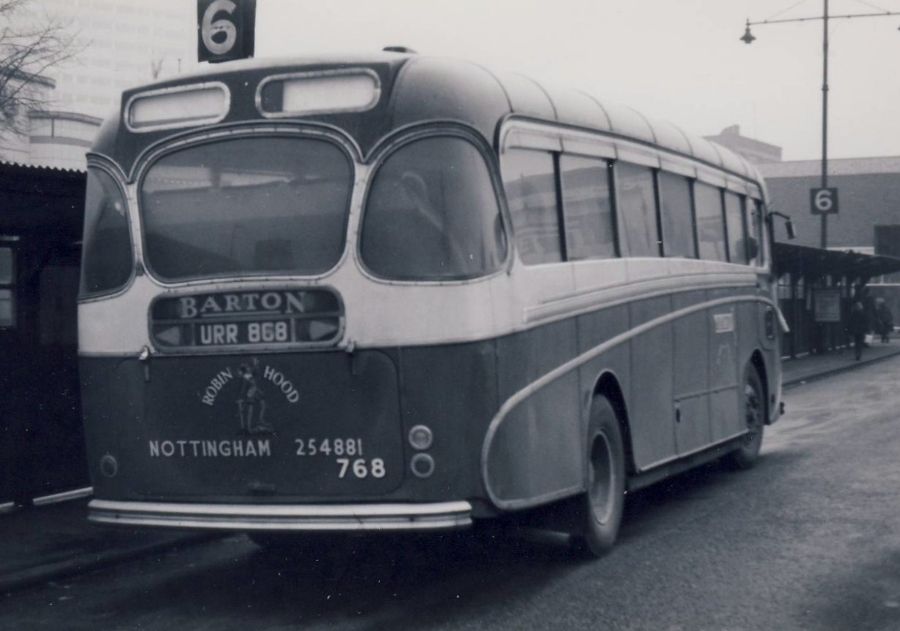
-
There is still a free bus service for the city centre, Centrelink, run by TrentBarton on behalf of Nottingham City Council.
That's good - we might sample that next time we're in Nottingham (maybe next year), although my son likes having rides on the trams..
-
Remember this?
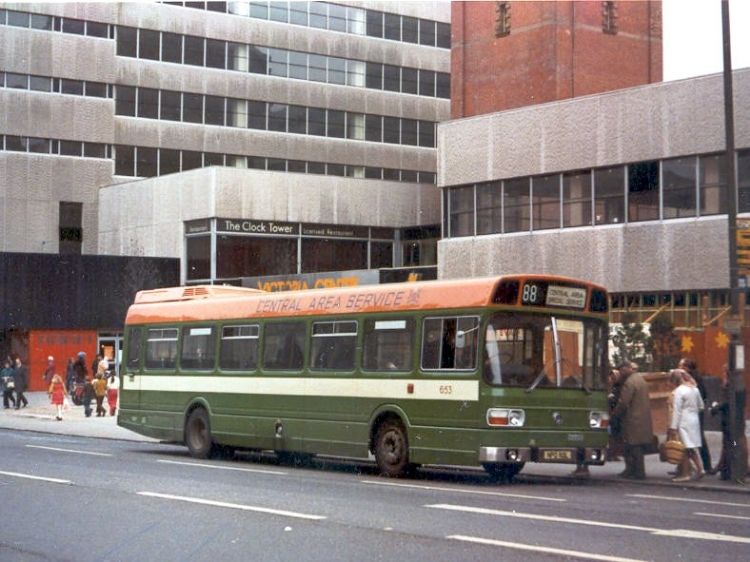
I'm quoting here largely from the book 'Nottingham City Transport' by F. P. Groves (published 1978): 'In 1972 the City Council adopted a new Transportation Policy...including the introduction of free central-area services.'
The central-area services, nos 77 & 88 were due to the establishment of the two shopping complexes at the Victoria and Broad Marsh Centres and the introduction in April 1973 of pedestrianisation of some of the central area streets.
'Once a suitable route had been agreed, the City Council decided to introduce an experimental free bus service on a north/south axis, serving the greater part of the shopping area, the bus stations, and the multi-story car parks, from 6th November 1972. Four Leyland Nationals were hired fromLondon Country Bus Services to operate the service (no. 88), which had a 5 minute frequency, and they were delivered new...with orange roofs to denote the service.
'Because of the success of the service the Transportation Committe agreed in January 1973...that it should continue beyond the experimental period...It was decided that a second service on an east/west axis should be introduced later in 1973 (no. 77)...A yellow colour code was adopted for the roofs...The service proved to be not as popular as the original one...The services continued during the remaining life of the former City Council, until 31st March 1974 and upon local government reorganisation Notts County Council took over responsibility...financial support was reduced at the end of July 1977, and a 2p flat fare was introduced.'
My photo was taken in the early days of the service and shows one of the London Country buses. Later on, NCT acquired some Leyland Nationals of their own, plus they had some AEC Swifts of their own, including some ex-West Bridgford ones, which also operated the services - although without the coloured roofs, if I remember correctly.
The 88 shown in the photo turned right along Parliament Street and then (I think) went along Maid Marian Way to reach the Broad Marsh Centre, but that's all I can remember of the route taken. I know the yellow-roofed 77s went via the General Hospital, but I can't remember anything else about that route - I may have travelled on it once for the ride, but there was never any need to go on it. In fact, once the novelty of having a free bus ride wore off I more or less stopped using the 88 as well and went back to walking everywhere. I'd certainly stopped using them by the time they started charging fares.
-
 1
1
-
-
Below is a photo of the back of a bus which shows a little of the buildings on the other side of Huntingdon Street, including Barton's depot. Just visible furthest right on this side of the road is part of Hughie's cafe.
The bus itself is Barton's no. 1182, a Bedford YRQ with bodywork by Willowbrook of Loughborough. It was new in 1971, so the photo was almost certainly taken in that year. If I'm a bit vague about some of the details of the photos I put on here I'm afraid it's because I was rather dilatory about recording details of what I photographed at the time.
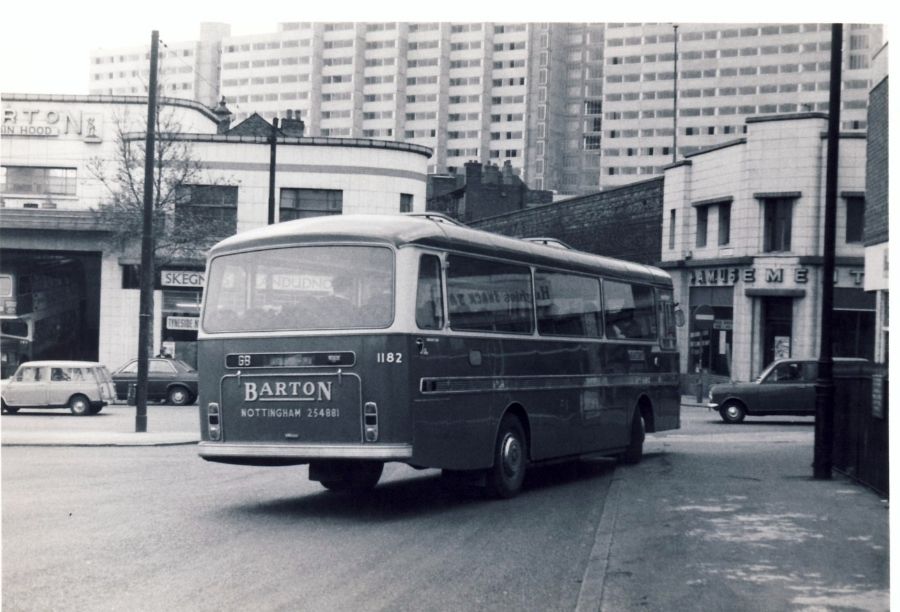
-
I may have seen you at Plumtree, Firbeck, but that Huddersfield trip was the only one I went on myself - quite a long journey in a 30-year-old vehicle, but I don't remember any mechanical difficulty. I do remember the seats were past their best - i.e. the padding had gone a bit thin!
You're right about Halifax Corporation - below is a photo I have to hand (i.e. already on the computer). It's their no. 8, a Leyland Royal Tiger Worldmaster, which was a type mainly produced for export - and I don't think even Barton had any of those! (they had just about everything else).
Perhaps the bus depot you visited in Wakefield was West Riding's? It was their main base of operations. My friend Terry Walker from the Huntingdon Street days later went to work for them.

-
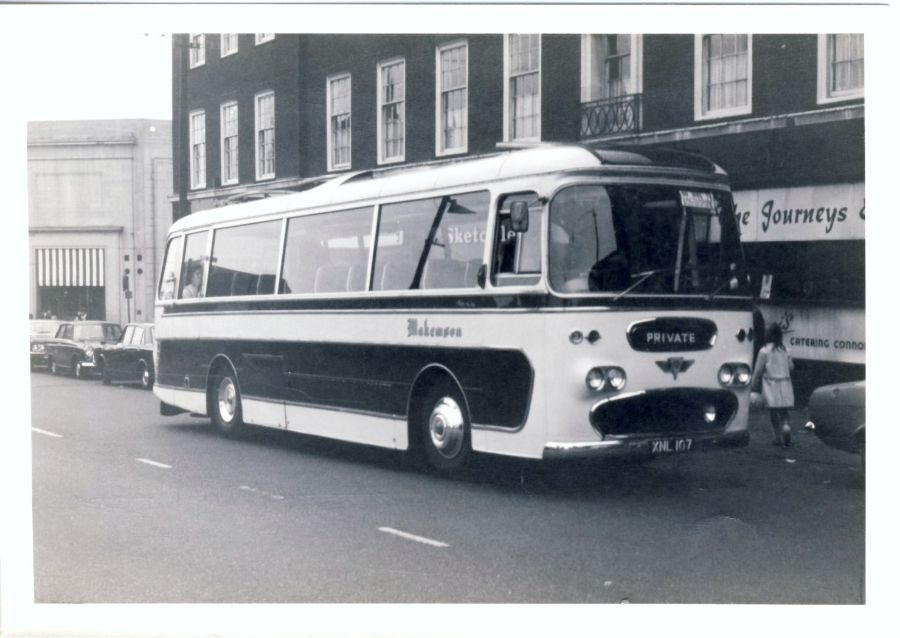
I've dug out this photo which shows the cafe on Huntingdon Street I mentioned was in fact called 'The Journeys End', not Capocci's after all.
The coach is Makemson's of Bulwell AEC Reliance, registration XNL107. The sticker in the windscreen says 'On Hire to Lincolnshire' so it's probably just arrived from Mablethorpe or somewhere. The photo must have been taken in 1970 or 1971.
-
I must say I was pleasantly surprised on seeing this thread to find the Savoy was still open. I used to go there occasionally in the 1970s/1980s, when there was nothing worth seeing in the town centre cinemas, although it was a bit of a bind walking out that way. I saw 'Gone With the Wind' there! (on a re-release in the period I mentioned, not when it first came out!).
-
Related to this subject, with regard to the end of trolleybus services in turn, I always understood it was said to be due to the number of road improvement and alteration schemes that were planned for the 1960s and which would have meant costly work on altering the trolleybus routes to fit the new road layouts.
I have a book, 'Nottingham City Transport' by F. P. Groves, published by Transport Publishing Company in 1978, and all it says on the subject is: 'During the financial year 1961/62 the gradual abandonment of the trolleybus system was approved by the City Council'. This book does support what Stephen Ford says in his second paragraph above about the ending of tram to trolleybus conversion.
-
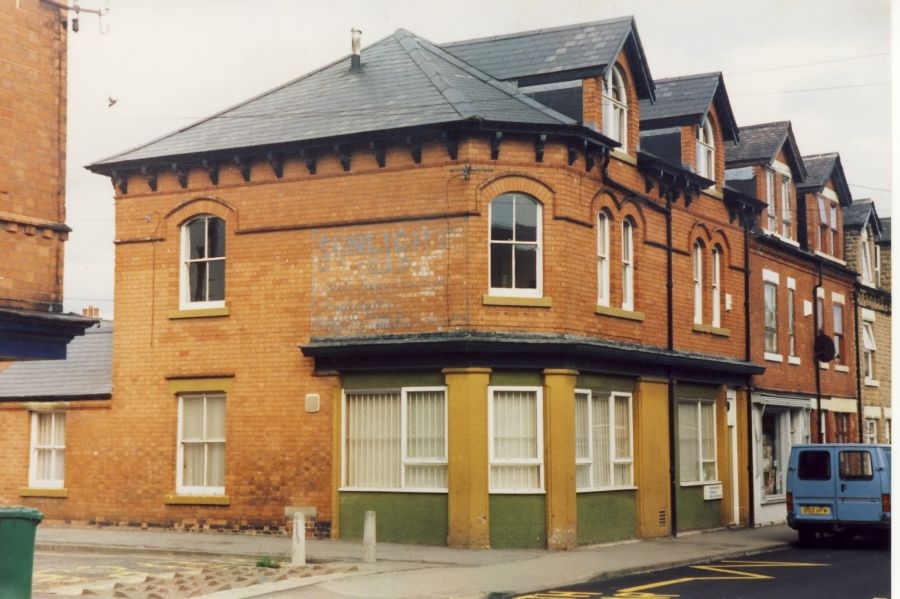
Here's a photo from me - this is no. 88a Commercial Road on the corner of Latham Street. It was originally a shop, but at some time in, I think, the 1950s, it became an office of the Ministry of Pensions & National Insurance (later Social Security). When they moved out to David Lane at Basford in 1971 it was used by the Probation Service, but I believe they had also moved out by the time of this photo in 1996. It did seem to be occupied then, but I don't know who by.
-
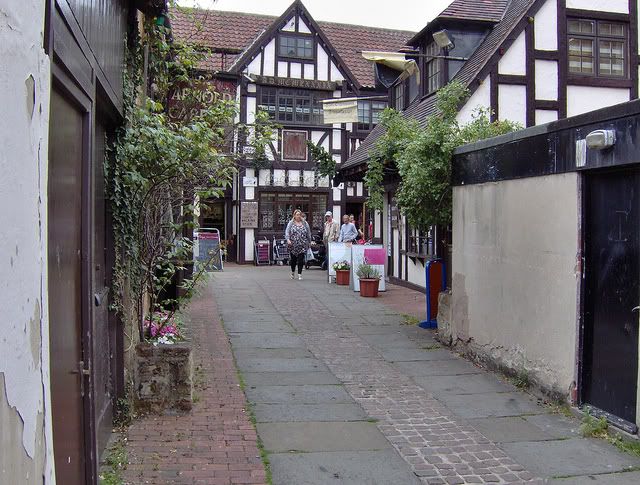 Near Bulwell Market 2011.
Near Bulwell Market 2011.Entrance to this arcade is in Bulwell Market also off Commercial Road.
This has got me puzzled. It's not all new building in half-timbered style is it? I worked in Bulwell from 1966 to 1971 and lived there from 1980 to 1997 and I don't remember that area at all. Admittedly in the latter period I never went round there at all, but going back to the late 1960s/early 1970s I thought it was Duke Street just there - and although I may be wrong, I don't remember any buildings like that.
In the days before the new road was built across there (Bulwell High Road is it?), as I remember it, going down Commercial Road towards the Market you went past the post office on the corner on the left, then if you didn't want to continue on down what was nicknamed Star Lane to the Market you turned left along Robinson's Hill and went down Duke Street to Main Street. And although after over 40 years I can no longer picture what Duke St. was like I don't remember that area at all. Anyone else remember that area in those days?
-
Just come across this thread.
The Barton double decker referred to was their no. 816, a Leyland Titan TD4 dating from 1936 with 1949 ECW bodywork, acquired by Barton in 1959 from Cumberland Motor Services. There's a picture of it here:
http://www.flickr.com/photos/23207961@N07/3652055102/
According to my diary it was Sunday 17th April 1966 when it was used on a trip to Huddersfield for the members of the Nottingham Trolleybus Group
to go on an organised tour of the Huddersfield Trolleybus system. I went on it because I knew the driver who lived nearby (can’t remember his name).I’ve written on another thread about summer Saturday bus spotting days at Huntingdon Street bus station, and I remember an occasional participant
called Keith Turner who was a member of the Nottingham Trolleybus Group and we’d hear all about it from him. Apparently the idea was to eventually run the trolleybuses from the station yard down the driveway to the main road, where a turning circle would be provided. I visited there on at least one occasion, which would have been in the 1965/66 period. I’m not sure if the railway was still in use for very occasional freight traffic, but didn’t see any trains. A year or so later I lost touch with what was going on there, so I don’t know why the museum idea fell through. Not many years later the trolleybus museum was established at Sandtoft near Doncaster, and I believe some of the vehicles from Plumtree went there. -
Here's a few random memories from me about Mablethorpe.
Must have visited there several times on day trips over the years, but only ever stayed there once - for a week or so with my mother in either 1958 or 1959. I can’t be sure, but I don’t think it was a bed & breakfast place we stayed in, but took rooms or a flat. What I do remember is that it had gas lighting.
We spent nearly every day on the beach, and always seemed to have sardine sandwiches for a picnic lunch. A highlight of the beach for me was the ‘sand train’, which was either this one or one very like it:-
http://www.nfa.dept.shef.ac.uk/images/quiz03.jpg
We went to the cinema (was it called the Lyric?) almost every evening we were there (no TV where we were staying!). There seemed to be a different film on every night, and I remember we were able to book seats in advance like in a theatre. Two films that I can remember seeing were ‘Boy on a Dolphin’ with Sophia Loren, and ‘The Deep Blue Sea’ with Kenneth More.
One day we had a train ride to Louth, but it was early-closing day and there was nothing to do but look in shop windows! As stated on an earlier post, Mablethorpe was on a railway line from Willoughby, which continued on to rejoin the Boston – Grimsby line at Louth. The Mablethorpe to Louth section
closed at the end of 1960.I always remember my parents telling me about how the sand dunes at Mablethorpe had been mined during the war, and in relation to that, there used to be a gate leading into a wood somewhere in Lincolnshire along the way to not just Mablethorpe, but also the other places like Chapel St Leonards and Skegness, which had a notice on it: ‘Beware of Mines’ (or words to that effect). Why there were mines in that particular area I couldn’t say. The thing is that the war even to people of my generation born a few years afterwards (1950 in my case) was something from history, something you read about in comics or saw in the films on TV on Sunday afternoons. But in the late 1950s it was only 13 or 14 years before, and when you think back to 13 or 14 years ago from NOW it seems like only yesterday. The mines in the sand dunes and so on must have all seemed so recent to my parents.
-
 1
1
-
-
Further to my earlier posting, here's a photo of a Trent Daimler Fleetline on route 62 on Mansfield Road, Sherwood in the late 1960s. Note the lamp post in the centre of the photo supporting the street light over the centre of the road - what we used to call a 'traction pole', left over from the tramway days. They were all the way along there at that time (I don't suppose they still are) used for street lights instead of trolley wires as originally.
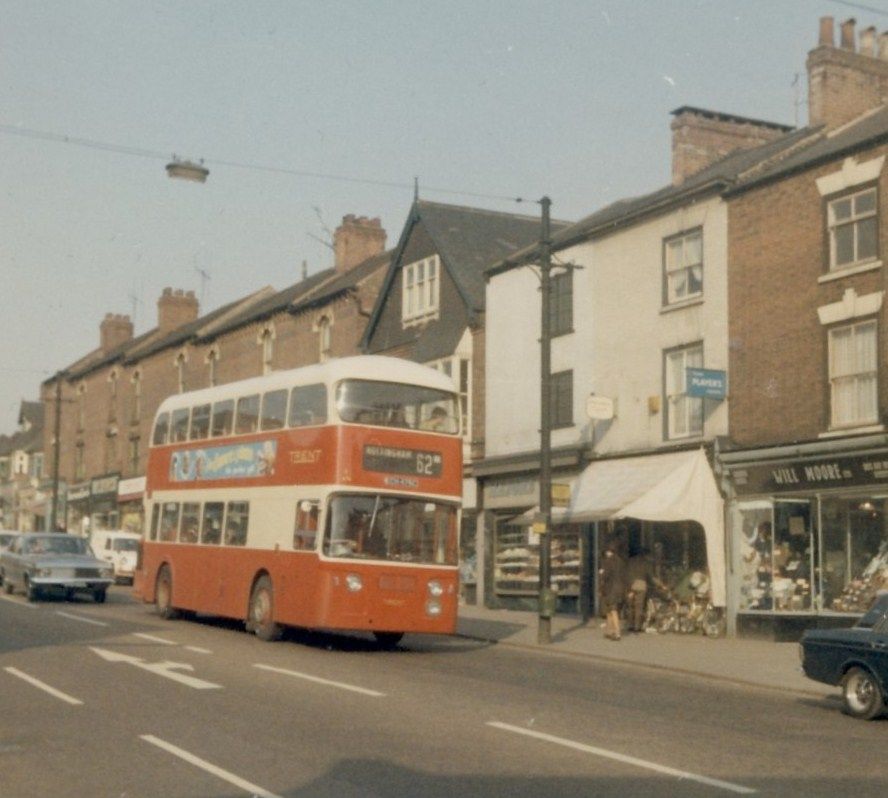
-
 1
1
-
-
I have a good few was going to say "as it is now pics" but thinking about it they are 10-20 years old! so doubt it's like that now! if anyone wants to see will post here
Please do.
-
Just been having a look at timetables (on the Nottingham Victoria website http://homepage.ntlworld.com/nick.willis/ ). It isn't conclusive because the 1961/62 timetable isn't there. The following year which was the last that the GC had a proper through service including South Yorkshireman, Master Cutler etc, shows no northbound departures from Victoria between 8.16 (Leicester - Sheffield stopper) and 2.00 (Leicester - Chesterfield stopper), then the York at 4.39. The 1957 timetable extracts don't include the midday period. The 1954 timetable does show a 12.54 from Vic which was the 10.00 Marylebone - Manchester, but this is a bit early for your estimate of 1.30 - 2.00. Then I noticed a 1.17 departure (8.05 Bournemouth - Newcastle). Unfortunately this turned out to be Saturdays only (and only running 17 July - 28 August, which was probably outside school term anyway).
As you say, it's not completel;y conclusive because it's a year after the time I was remembering - but I notice there was the southbound York - Bournemouth due at Victoria at 1242. It's just possible that it was this train frequently running quite a bit late that we used to see, and that my memory is playing false in thinking it was seen northbound. Then again it could have been some other service that had stopped running by September 1962.
You mention 1962/63 as the last year in which the South Yorkshireman and the Master Cutler ran, but I think they finished in 1960. That 1962/63 timetable actually shows no day-time trains from Marylebone going beyond Nottingham,
-
I suspect that the 1.35 and 1.50 ratholes would be one from Derby Friargate and the other from Pinxton South - which didn't close until 1963.
Interesting that you mention the York - Bournemouth. If it was northbound, that must have been after school. From memory going back to the 1950s (when I often saw it striding over the top of Nottingham Midland while waiting for a train back to Sawley Junction) it got to Nottingham Victoria about 4.30 (having left Bournemouth around 10.00). Southbound it left Vic at about 12.45. Coach roofboards proclaimed "BOURNEMOUTH - OXFORD - YORK"
I'm sure I remember it heading north - and it would definitely have been between 1.30 and 2pm. Maybe a bit of research is called for - I believe there were still one or two other cross-country services at that time, so maybe it could have been one those rather than the 'Yorkie' as we thought.
-
I recently acquired a copy of this book on Ebay:
I can recommend it for photos of Huntingdon Street and elsewhere in the Nottingham area, which form the majority of the photos in it as the photographer G H F Atkins was a local man.
-
Nice bus. No, it was certainly a double-decker bus with a closing door at the front.

One of these?
This particular one was actually part of the Standerwick fleet which was a subsidiary of Ribble. They were a common sight belting up and down the M1 on Lancashire to Londons services. This photo was taken at Victoria Coach Station in London.
They were Leyland Atlanteans with coach seats, and as you say a stewardess would come round with refreshments. There was also a toilet on board at the back of the lower deck.
They were branded as the 'Gay Hostess' services - they wouldn't be today!



Bulwell Common Station
in Pete's Nottingham Transport Forum
Posted
And for years it had graffiti on it saying; 'Vote Peck X'.